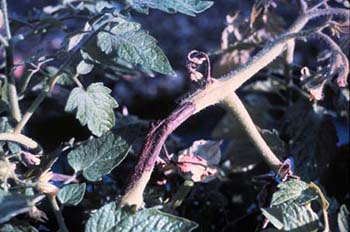Tomato late blight disease is widespread in home gardens.
Late blight (Phytophthora infestans) is a disease that most commonly affects potatoes, but can infect tomatoes in some years. When the weather is favorable, as it has been in 2014, late blight can be especially troublesome.
This disease was recently reported in Michigan from a commercial potato field in Allegan County. The late blight spores from this infected potato field can infect nearby tomatoes. Tomato growers practicing integrated pest management use fungicides to protect against early blight, Septoria and anthracnose, and many of these fungicides also provide adequate protection against late blight.
Late blight symptoms include blighting on all aboveground parts of the tomato plant. Lesions on leaves often appear dark and oily with production of spores occurring on the undersides of the leaves, resulting in a purplish appearance, especially when conditions are wet and humid (Photo 1). Blackened lesions on the stems also occur and are unique to late blight disease (Photo 2). Late blight affects green and ripened tomato fruits (Photo 3). The other commonly occurring tomato diseases do not cause a rot of the green fruit. The blighting on fruit from late blight appears as dark, greasy areas that enlarge rapidly, encompassing the entire fruit. During wet and humid conditions, white threads (mycelium) can be seen on the fruit.

Photo 1. Late blight lesions on tomato foliage. All photos by Mary Hausbeck, MSU

Photo 2 Late blight lesion on a tomato stem.